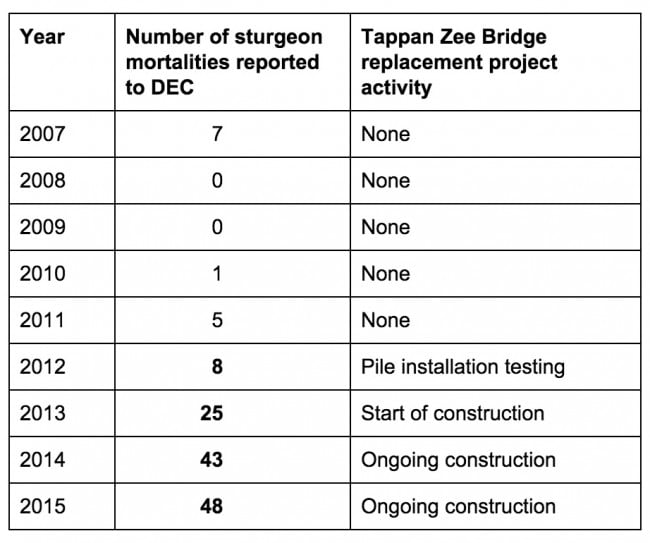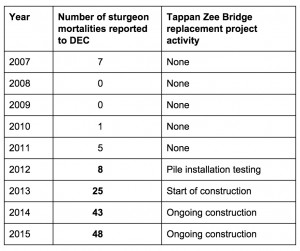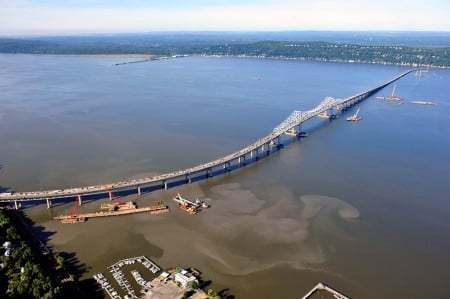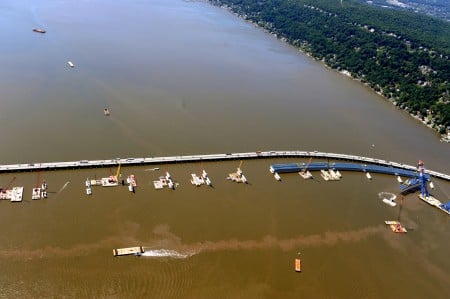Riverkeeper puts NYS on notice over Endangered Species, Clean Water Act violations at Tappan Zee project site

View more images on our Flickr site
For Immediate Release: December 19, 2015
Contact: Leah Rae, Staff Writer and Media Specialist
(914) 478-4501 ext. 238 or [email protected]
Violations include illegal toll on sturgeon and resuspension of polluted sediment.
Ossining, N.Y. – Riverkeeper announced today that it has put the New York State Thruway Authority and Tappan Zee Constructors LLC on notice for taking an illegal toll on sturgeon and resuspending excessive sediment – violating the Endangered Species Act and the Clean Water Act – during the ongoing Tappan Zee Bridge replacement project.
Pace Environmental Litigation Clinic, representing Riverkeeper, served notices of intent to sue both entities on Wednesday, December 16. The notices involve two distinct issues, both related to construction activity for the new Tappan Zee Bridge.
Riverkeeper seeks immediate compliance with federal environmental laws and related state permits for the bridge project.
The violations are as follows:
1.) The New York State Thruway Authority and its contractor, Tappan Zee Constructors LLC, have violated limits set by the National Marine Fisheries Service on the bridge project’s impact on endangered Atlantic and shortnose sturgeon in the Hudson River Estuary. (Click here for the NOIS).
The Endangered Species Act prohibits the “taking” (i.e. harassing or harming) of endangered and threatened species, though exemptions may be granted for particular projects if the taken individuals will not jeopardize the continued existence of the listed population. In this case, the Fisheries Service, part of the National Oceanic and Atmospheric Administration, studied the potential impact of the Tappan Zee Bridge replacement project on the two sturgeon species. The resulting “incidental take permit” allowed no more than two mortalities of Atlantic sturgeon and two mortalities of shortnose sturgeon by dredging or pile driving over the entire course of the project.
The reality: Since the project began in 2012, reported sturgeon mortalities along the Hudson have increased 20-fold, according to New York State data obtained by Riverkeeper through the Freedom of Information Law.
Sturgeon Mortality

Riverkeeper created a Google Earth map of the approximate locations of all the sturgeon moralities reported in 2013, 2014 and 2015. It charted 56 mortalities during those years that are likely to have resulted from vessel strikes, based on a review of state records.
The Fisheries Service permit did not allow the killing of any Atlantic or shortnose sturgeon from vessel strikes, on the assumption that project boats “will be traveling at slow speeds (less than 6 knots).”
The reality: Project boats routinely exceed 6 knots. This puts the vessels, including tugs and high-speed crew boats and their propellers, in close proximity to sturgeon, and leaves little time for the large slow fish to avoid collisions. As the Fisheries Service noted in its study, “Sturgeon may also be better able to avoid slow moving vessels than fast moving ones.”
2.) The Thruway Authority and Tappan Zee Constructors have violated the Clean Water Act and New York State permit restricting the resuspension of Hudson River sediment – in effect, the discharging of pollutants – through construction activity. (Click here for the NOIS).
Aerial photos of the project area show numerous dates on which construction activities have caused substantial resuspension of bottom sediments and enormous discharges of highly turbid water that have caused visible contrast to the national conditions of the river. Many of these discharges appear to extend well beyond the permitted “mixing zone” around these activities, as specified in the state permit for the project.
Turbidity indicates that stirred-up sediment is covering habitat at the river bottom, disrupting the food chain that supports bottom-feeders such as endangered sturgeon. It also indicates that contaminants buried in layers of sediment are being released into the water, further threatening the health of the river.
The New York State water quality standard for turbidity in all surface waters is “no increase that will cause a substantial visible contrast to natural conditions.” The permit for the Tappan Zee project includes this standard and requires monitoring of contaminants “at the edge of the 500-foot mixing zone” around activities that may resuspend bottom sediments. The permit specifically requires monitoring for mercury, PCBs, naphthalene, benzo(a)pyrene, nickel, copper, lead and zinc.
Each letter gives 60 days’ notice of Riverkeeper’s intent to file a citizen suit seeking compliance with the law.
Riverkeeper continues to monitor the bridge replacement project. In 2013, Riverkeeper and Scenic Hudson reached an agreement with New York State on the terms of the DEC permit, incorporating stronger protections for water quality and vulnerable fish species such as Atlantic sturgeon.
These aerial photos taken in 2013 and 2015 show how Tappan Zee Bridge project activities have caused the resuspension of bottom sediments, causing enormous plumes of turbid water, in clearly visible contrast to the natural conditions of the Hudson River estuary.
Photos: Lee Ross



